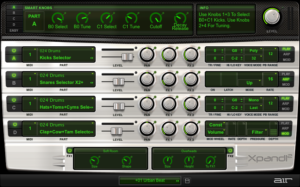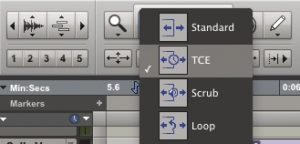In this article i wanted to talk about how i use samples to fill out a drum n bass track. Lately, I’ve been using virtual instruments to make the main parts of my track, then i’ll use certain types of samples to make it more complex and more interesting.
You can download some royalty free samples to try out, if you sign up for my newsletter here.
There are certain elements i use in almost every drum n bass track. They include drums (kick, snare, and high-hat), a bassline, a lead melody, usually a chord progression, some additional percussion, and also some ambient sounds to fill out the sound in particular parts of the song like the intro or breakdown.
For the album i’m making now, i’ve been using a mix of programmed virtual instruments (xpand2 that comes  with protools), samples, and sometimes live instruments (i play guitar). I’m going to put a layer of live guitar on top of my tracks to fill it out and emphasize the chord progressions.
with protools), samples, and sometimes live instruments (i play guitar). I’m going to put a layer of live guitar on top of my tracks to fill it out and emphasize the chord progressions.
I’m not really into buying lots of plugins, I just use the stock plugins that come with protools. I think its more important that you use your plugins creatively, than to blame your gear as the reason your music doesn’t sound good.
Starting a New Track
I’ll usually start a new track by programming a main melody or bassline with midi. OR, i’ll find a sample with a melody or bassline i want to base the song around.
I’ll find or make about 6 parts that work together, then or add them in or pull them out as the song progresses. Its important to that each part of a track is strong. If your song doesn’t sound good, make better parts instead of adding something on top of it.
I like to make basslines the part of the track that everything else is built around. In bass music, its important for the bass to be wide and move along with the kick.
I’ll add effects like distortion, lo-fi, and eq to improve the tone and width of the bassline. I might also use a little chorusing or flange to make the tone change as the song progresses. You can also use filters with plugin automation to change the tone of the bassline in certain parts of the song.
With the lead melody, i will usually add some reverb, delays, flange, eq, and/or chorus to address the wideness of the melody and help it stand out in the track.
I love using midi. I used to play the parts on a keyboard and work with the audio, but lately i’ve switched to programming them with midi because i’m not that great of a keyboard player and its much easier.
Midi is great because it allows you to change the melody, progression, or bassline as the song develops. Sometimes you get new ideas and get sent in different directions as the song progresses, midi makes it really easy to change it without having to replay the part.
I’ve found that if you focus on creating an interesting melody, bassline, and chord progression, you really don’t have to do that much else. The song will sound good based on a well written melody, chord progression, and bassline. If you have that, mixing the song is easy. If your song sucks, make better parts.
After i have a cool melody or bassline, i’ll usually add a drum loop. This will quickly give me an idea of how the track will sound with drums.
After this, i will layer more individual drum samples on top of the loop.
Layering Drums
After i’ve got a couple parts and a drum loop, i’ll add a second layer of drum sounds on top using individual drum samples placed on the grid in pro tools.
I’ll add in a nice sounding 808, another snare, and another high hat on top of the loop.
Adding multiple layers of drum loops and individual drum samples on top of each other help create a layered, more complicated drum sound that is important in drum n bass music.
Creating a lead melody or main loop
Interesting loops can be found in any piece of audio. I work hard to create a strong main melody or find a loop that is good enough to carry the song.
To find a good loop in a piece of audio, I’ll import some audio that i like, then highlight different sections of the audio in pro tools, then I’ll listen to them on loop playback. I’ll do this until i find a good repeating piece of audio that is strong enough to use as my main loop.
Or if i dont use a loop, i’ll program my lead melody with midi.
I love sampling songs, but I don’t really want to worry about copyright, so i will usually work with royalty free sample packs, and find a piece of audio that i like, or i’ll program it in with a virtual instrument.
A loop is just a piece of audio that is a starting point for you build a part with. I always change the loop. The loop will almost always sound different after i alter, manipulate, chop up, or layer the samples on top of each other. It will usually sound nothing like the original sample.
I like to add some samples once the basic parts are laid out. Mixing in loops can also give you new melody ideas or chord ideas and send you in directions you might not have thought about.
When i pick a sample, i’ll look for ones to use which are in the same key as the song or will shift the pitch of the sample to match the key of the track. You can also use samples that are in relative keys to your track. https://en.wikipedia.org/wiki/Relative_key
Sample packs is a cheap, quick way to work with audio from something you might not have had access to like an orchestra or choir. If you were going to hire an live musicians, it would be really expensive and a pain to setup.
Filling out a sound with ambient samples
When i have the basic elements of a song together (melody, bassline, drums), i will use ambient and percussive samples to thicken up and add some variation to the track.
I tend to mix in ambient samples on the intro, outro, breakdown, and the 2nd half of the lead melody part to make it more interesting.
I also like to add lots of reverb or delay to make the sounds very wide when contrasted with the main melody part.
Its a cool effect when you have a melody playing by itself (with no drums) for about 4 bars during a breakdown, then bring in a wide, reverbed out, ambient part. The contrast between these parts sounds really cool.
Adding Percussion and FX
If you buy a sample pack, there will usually be a folder called “one shots”
One shots are just short stabs of a percussive sound, ambient sound, or chord that you can use in a pattern throughout the track, or very loud at transition points in the song.
I usually add one shots every 4 – 8 bars, or in a pattern as percussion.
I look for fx samples that have a unique tonal characteristic in the high or low range that might be missing from my track and use it fill out the frequency spectrum.
Filling out the entire range of frequencies with different instrumentation is what phil specter did with his “wall of sound”. This makes the song sound full and finished.
Changing the BPM and pitch of a sample
It is nice when you find a sample that fits the exact key and tempo of the
 track you are working on.
track you are working on.
But most of the time you will have to stretch the sample or shift the pitch to get it to fit into the track you are working on. In protools you can do this pretty easily using the time stretch tool. Here’s a video that shows you how to use time stretching in pro tools.
In my experience, if the sample is plus or minus 10 bpm of the track you are working on, you will be able to get it to stretch or shrink without any artifacts.
But if there is any more of a difference than about 10 bpm, there may changes in how the sample sounds when it is stretched or compressed.
Also, if you have to shift the pitch too much, you can also have some artifacts which ruin the sample. This is especially true in the low bass frequencies. Sometimes shifting the pitch in low frequencies can produce an unusable sample.
But, altering the pitch of higher frequency samples will usually work without too much damage to the sound quality. But if the pitch is shifted to much, it can make it unusable.